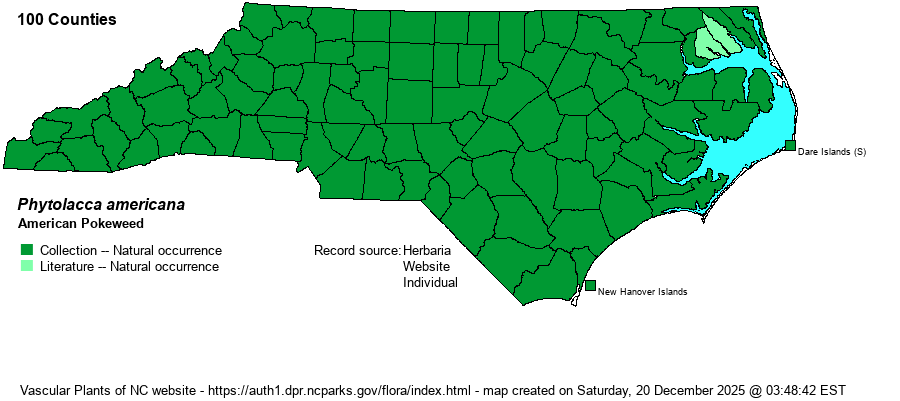| Section 6 » Order Caryophyllales » Family Phytolaccaceae |
Show/Hide Synonym
| taxonName | relationship | relatedTaxonName | relatedTaxonRefText | relComments |
|---|
|
|
|
|
|
|
|
|
|
| Phytolacca americana | < | Phytolacca americana | Godfrey and Wooten (1979, 1981) | | | Phytolacca americana | < | Phytolacca americana | Radford, Ahles, and Bell (1968) | | | Phytolacca americana | < | Phytolacca americana | | | | Phytolacca americana | < | Phytolacca americana | Wunderlin & Hansen Flora of Florida (3) | | | Phytolacca americana | = | Phytolacca americana var. americana | Flora of North America (1993b, 1997, 2000, 2002a, 2002b, 2003a, 2004b, 2005, 2006a, 2006b, 2006c, 2007a, 2009, 2010) | | | Phytolacca americana | = | Phytolacca americana var. americana | | | | Phytolacca americana | = | Phytolacca americana var. americana | | | | Phytolacca americana | = | Phytolacca americana var. americana | | | | Phytolacca americana | = | Phytolacca americana var. americana | Flora of Virginia | | | Phytolacca americana | = | Phytolacca americana var. americana | Rohwer in Kubitzki, Rohwer, & Bittrich (1993). | | | Source: Weakley's Flora |
|
| Author | L. | |
| Distribution | Throughout the state, though apparently scarce in the far northeastern corner.
This is a very widespread Eastern species, found in nearly every county in its range. It occurs from eastern Canada south to southern FL and west to most of TX.
| |
| Abundance | Common to very common and widespread statewide, though uncommon in the far northeastern counties, where there is no specimen for two counties north of Albemarle Sound. | |
| Habitat | This is a very wide-ranging species in habitats, usually in disturbed soil, where birds deposit seeds. It grows best in rich to mesic soils of wooded borders and moist clearings and wooded openings, often quickly invading treefall gaps in forests, for example. It also grows in farmyards and vacant lots, as well. |
| Phenology | Blooms from May to frost, with fruit ripening in fall. | |
| Identification | This is a very familiar native, being essentially the most robust herb seen in most of the state. It has one to several stems from the base, each often 1-inch or more thick, and it grows to 6-9 feet tall. It has alternate and smooth leaves, lanceolate to nearly elliptic, about 6 inches long and 2 inches wide, at times larger than this. The flowers are in long racemes, spreading and then often drooping, from leaf axils. Each flower consists of 5 greenish to whitish sepals (but no petals); however, much more conspicuous are the dark purple berries that appear in fall, each about 2/5-inch across. These berries are favorite food items of birds such as American Robin and Gray Catbird. Along the coast grows the rare P. rigida. Check that species account for separation characters. | |
| Taxonomic Comments | None, though some references include varieties, probably with P. rigida as a variety. Weakley (2018) separates the latter as a good species.
| |
| Other Common Name(s) | Often named simply as "Pokeweed", but with P. rigida being given species status, a common name for it must also be "xxxxxx Pokeweed". Thus, a modifier name for P. americana is recommended. Common Pokeweed is another suitable name. | |
| State Rank | S5 | |
| Global Rank | G5 | |
| State Status | | |
| US Status | | |
| USACE-agcp | FACU link |
| USACE-emp | FACU link |

